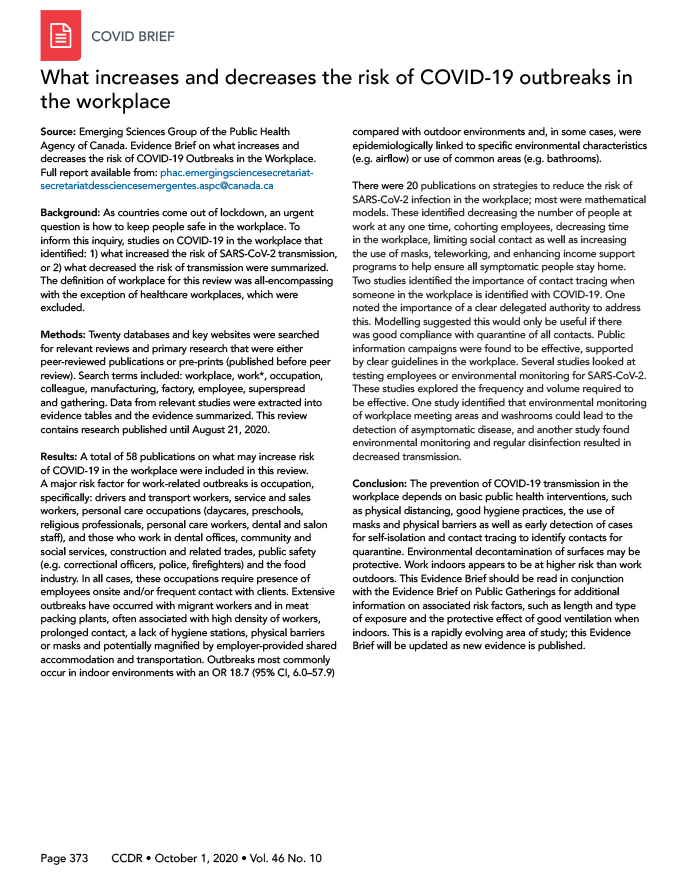Risks of COVID-19 in the workplace

 Download this article as a PDF
Download this article as a PDFPublished by: The Public Health Agency of Canada
Issue: Volume 46–10: Laboratory Biosafety
Date published: October 1, 2020
ISSN: 1481-8531
Submit a manuscript
About CCDR
Browse
Volume 46–10, October 1, 2020: Laboratory Biosafety
COVID brief
What increases and decreases the risk of COVID-19 outbreaks in the workplace
Source: Emerging Sciences Group of the Public Health Agency of Canada. Evidence Brief on what increases and decreases the risk of COVID-19 Outbreaks in the Workplace. Full report available from: phac.emergingsciencesecretariat-secretariatdessciencesemergentes.aspc@canada.ca
Background: As countries come out of lockdown, an urgent question is how to keep people safe in the workplace. To inform this inquiry, studies on COVID-19 in the workplace that identified: 1) what increased the risk of SARS-CoV-2 transmission, or 2) what decreased the risk of transmission were summarized. The definition of workplace for this review was all-encompassing with the exception of healthcare workplaces, which were excluded.
Methods: Twenty databases and key websites were searched for relevant reviews and primary research that were either peer-reviewed publications or pre-prints (published before peer review). Search terms included: workplace, work*, occupation, colleague, manufacturing, factory, employee, superspread and gathering. Data from relevant studies were extracted into evidence tables and the evidence summarized. This review contains research published until August 21, 2020.
Results: A total of 58 publications on what may increase risk of COVID-19 in the workplace were included in this review. A major risk factor for work-related outbreaks is occupation, specifically: drivers and transport workers, service and sales workers, personal care occupations (daycares, preschools, religious professionals, personal care workers, dental and salon staff), and those who work in dental offices, community and social services, construction and related trades, public safety (e.g. correctional officers, police, firefighters) and the food industry. In all cases, these occupations require presence of employees onsite and/or frequent contact with clients. Extensive outbreaks have occurred with migrant workers and in meat packing plants, often associated with high density of workers, prolonged contact, a lack of hygiene stations, physical barriers or masks and potentially magnified by employer-provided shared accommodation and transportation. Outbreaks most commonly occur in indoor environments with an OR 18.7 (95% CI, 6.0–57.9) compared with outdoor environments and, in some cases, were epidemiologically linked to specific environmental characteristics (e.g. airflow) or use of common areas (e.g. bathrooms).
There were 20 publications on strategies to reduce the risk of SARS-CoV-2 infection in the workplace; most were mathematical models. These identified decreasing the number of people at work at any one time, cohorting employees, decreasing time in the workplace, limiting social contact as well as increasing the use of masks, teleworking, and enhancing income support programs to help ensure all symptomatic people stay home. Two studies identified the importance of contact tracing when someone in the workplace is identified with COVID-19. One noted the importance of a clear delegated authority to address this. Modelling suggested this would only be useful if there was good compliance with quarantine of all contacts. Public information campaigns were found to be effective, supported by clear guidelines in the workplace. Several studies looked at testing employees or environmental monitoring for SARS-CoV-2. These studies explored the frequency and volume required to be effective. One study identified that environmental monitoring of workplace meeting areas and washrooms could lead to the detection of asymptomatic disease, and another study found environmental monitoring and regular disinfection resulted in decreased transmission.
Conclusion: The prevention of COVID-19 transmission in the workplace depends on basic public health interventions, such as physical distancing, good hygiene practices, the use of masks and physical barriers as well as early detection of cases for self-isolation and contact tracing to identify contacts for quarantine. Environmental decontamination of surfaces may be protective. Work indoors appears to be at higher risk than work outdoors. This Evidence Brief should be read in conjunction with the Evidence Brief on Public Gatherings for additional information on associated risk factors, such as length and type of exposure and the protective effect of good ventilation when indoors. This is a rapidly evolving area of study; this Evidence Brief will be updated as new evidence is published.
